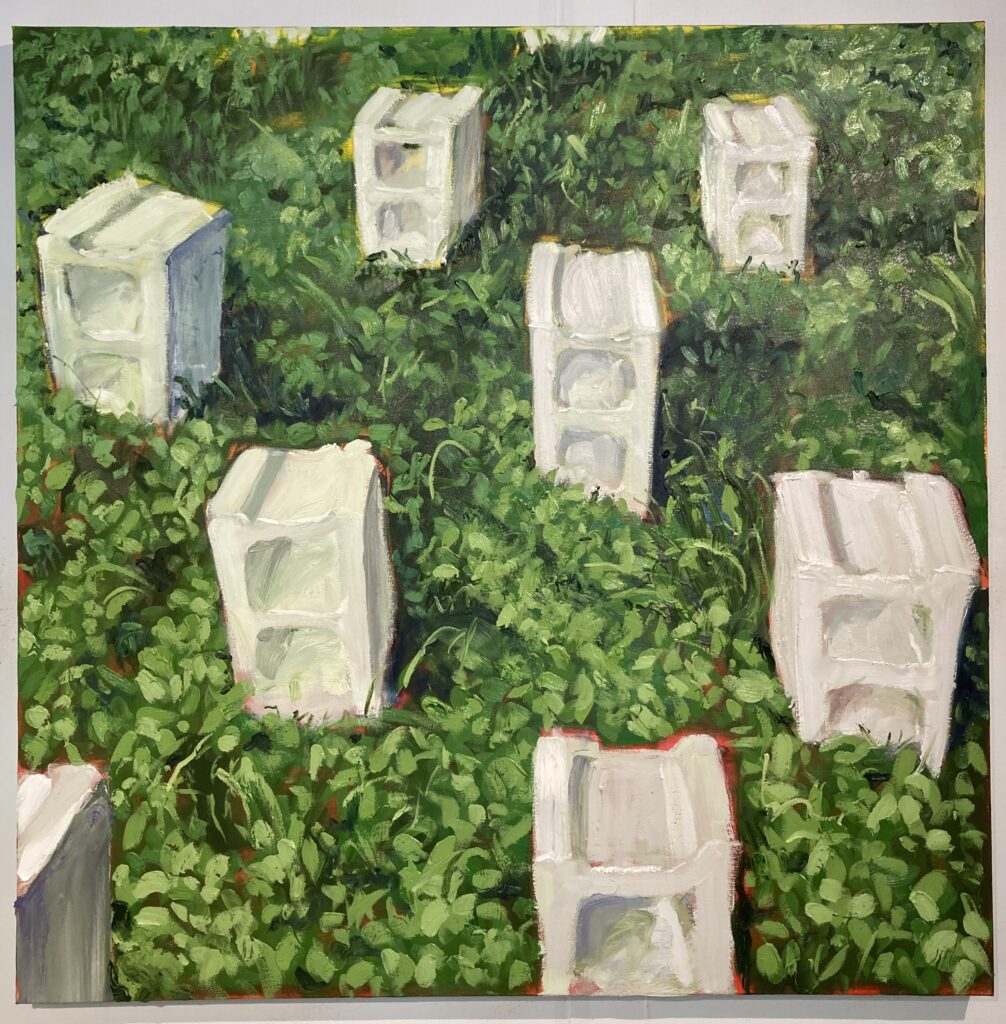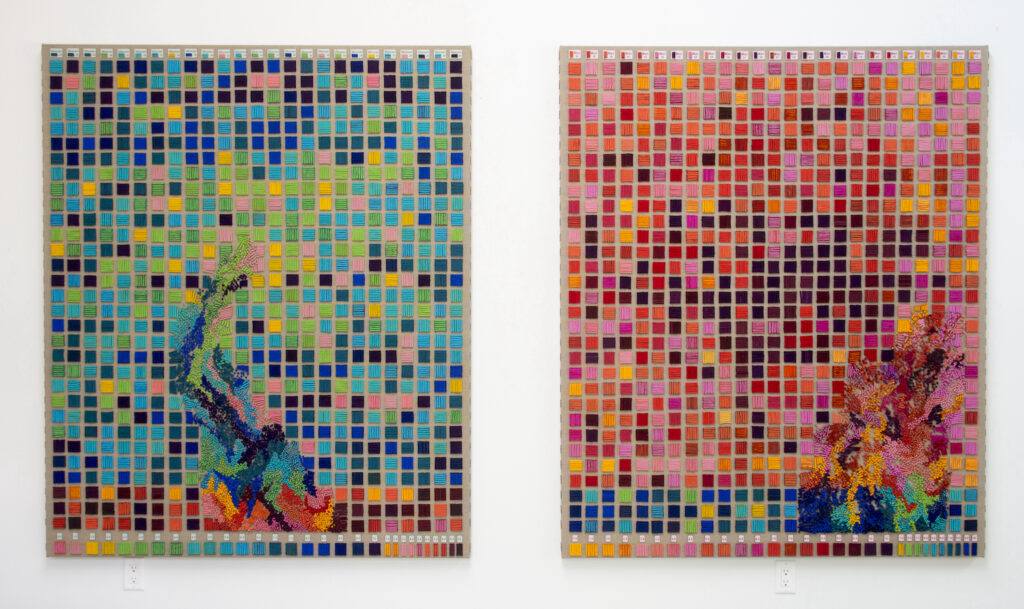Written by Kristine Corona, TAG Education Intern
Classes from a variety of different majors have visited The Art Galleries at ACC to explore the current exhibition Narrated Memories: Artworks by ACC Alumni Laurie Frick, Heather Parrish, and Michael Villarreal. To prepare for class visits, gallery staff work with ACC professors to create tours that overlap with their course projects and syllabi. For Learning Frameworks professor Eva Thomsen, this meant preparing a gallery tour that centered around arts-based mindfulness. In her Learning Frameworks course, Prof. Thomsen focuses her class projects on mindfulness-based learning and living. Along with achieving the standard learning outcomes for the course, these sections are designed to support student success and well-being by increasing students’ knowledge and use of regular mindfulness practices. Thomsen explains,
With my background in counseling and visual arts, I was aware of the rich opportunity art provides for expanding mindfulness. Among other benefits, mindfulness has been shown to decrease stress and anxiety; increase focus, attentional control, memory, cognition and creativity; and improve mood, emotional regulation, and self-regulation.
During the gallery tour, which was facilitated by TAG staff, Thomsen’s class was split into two groups. Utilizing the artworks, the class was guided through three different mindfulness activities: 5-4-3-2-1 grounding technique, close looking, and a no-look contour drawing.

Michael Villarreal, The Ground Work, 2023, oil on canvas, 50 x 50 in. Image courtesy of the artist.
Grounding Techniques
The grounding technique 5-4-3-2-1 can be used in times of high anxiety or overwhelm and activates our five senses to ground us to the present moment. Using our surroundings for this activity, students observed the gallery space around them and identified:
Five things they saw
Four things they could feel
Three things they could hear
Two things they could smell
One thing that they could taste
Beyond its use for settling anxious thoughts, the 5-4-3-2-1 grounding technique can also be an immersive way to engage with artworks. To practice this, students gathered around The Ground Work (2023) by Michael Villarreal and put themselves in the environment of the painting, which happens to be the artist’s backyard. They went down the list of senses and verbalized their experience, as if they were standing in Villarreal’s backyard. Students saw the cinder blocks and their orderly arrangement, as well as the patches of grass. They imagined hearing birds chirping, the crunching of the ground, and the clicking of crickets. They felt the itchiness of the grass and the wind on their skin. They imagined smelling vegetation, dirt, bug spray, or a barbecue taking place in the backyard. As students went through this technique, they experienced Villarreal’s artwork in a personal way that engaged all of their senses, while connecting them to the present moment.

Heather Parrish, Memory Worker II (that which we remember as distinct from that of which we are reminded) , 2022, polymer photogravure, 27 x 30 in. Image courtesy of the artist.
Close Looking
For the next mindfulness activity, students were separated into smaller groups of four and were given a Close-Looking worksheet. Each student group chose a single artwork to focus on, then in their groups, each student chose a single corner – or quadrant – of the artwork to closely observe. Students recorded their observations by describing what details, textures, colors, lines, or shapes they intuitively picked up on. Students were encouraged to take a deep breath and refocus if they found their attention drifting away from the artwork. As one student group looked at Memory Worker II (that which we remember as distinct from that of which we are reminded) (2022) by Heather Parrish, students noted how the artwork was composed of the same image of mass flooding that was mirrored and altered in each corner of the work. The students explained that the mirroring of the image and inverting of the colors caused them to see the flooding image in a different light. Students also observed that the flipping of the repeating photo and the inverting of its colors created a repeating eye-like shape in the artwork, a common motif found in Parrish’s prints. Many students realized that if they had not slowed down and taken the time to closely observe the work and discuss their findings with their classmates, they would have overlooked many of the features that the artwork has to offer. As we practice close looking, we strengthen our observational skills. Close looking is a skill that can be applied to our daily lives in order to help us slow down, digest information, and make discoveries during the process.
Contour Drawing
Lastly, students gathered around Felt Personality (2018) by Laurie Frick. For this activity, everyone took a moment to observe the artwork, then picked a single point to focus on. Using a pencil and paper, students were instructed to allow their eyes to travel around the artwork, while recording the path of their eye movements onto the paper. They were instructed to restrain from looking down at their drawings as they completed them, which allowed them to stay fully immersed in the artwork as their eyes wandered and followed the varying lines and contours. Some students recorded the rigid grid pattern of the data, while others followed the organic contours of Frick’s composition where the colors merge and flow together. This activity allows the participant to strengthen their connection between their eye and body movements, which promotes self-awareness. This mindfulness exercise can be done anytime as a way of taking a moment to enter a flow state and recenter yourself.

Continuous line drawings by ACC students. Based on Laurie Frick’s Felt Personality (2018).

Laurie Frick, Felt Personality, 2018, hand-dyed cut wool felt on stretched linen, 72 x 60 in. Image courtesy of the artist.
At the end of the tour, students were given a notecard and were told to finish the phrase “I noticed..”. While answers vary greatly from student to student, they highlight the takeaways students gained from exploring the intersection of art and mindfulness. Here are a few of the responses:
Student A: I noticed the more I looked at the paintings, the more calm it made me feel.
Student B: I noticed how meaningful/deep/beautiful everyday things can be if you just look for longer than a second and think.
Student C: I noticed that focusing on art pieces helps me to broaden my perspective.
The activities these students participated in are all a part of the larger topic of how art can promote personal wellness. The mindfulness techniques mentioned above can be used by anyone in a variety of ways, in and out of the gallery. When we gather together to discuss and explore art in these ways, we create a space where we connect not only to the art, but to ourselves, the people around us, and the surroundings we share.
Narrated Memories features artwork from ACC alumni Laurie Frick, Heather Parrish, and Michael Villarreal. It explores how memories are collected and rebuilt in our personal lives, as well as in broader social contexts. This exhibition is on view from September 5 – December 7, 2023.


Recent Comments